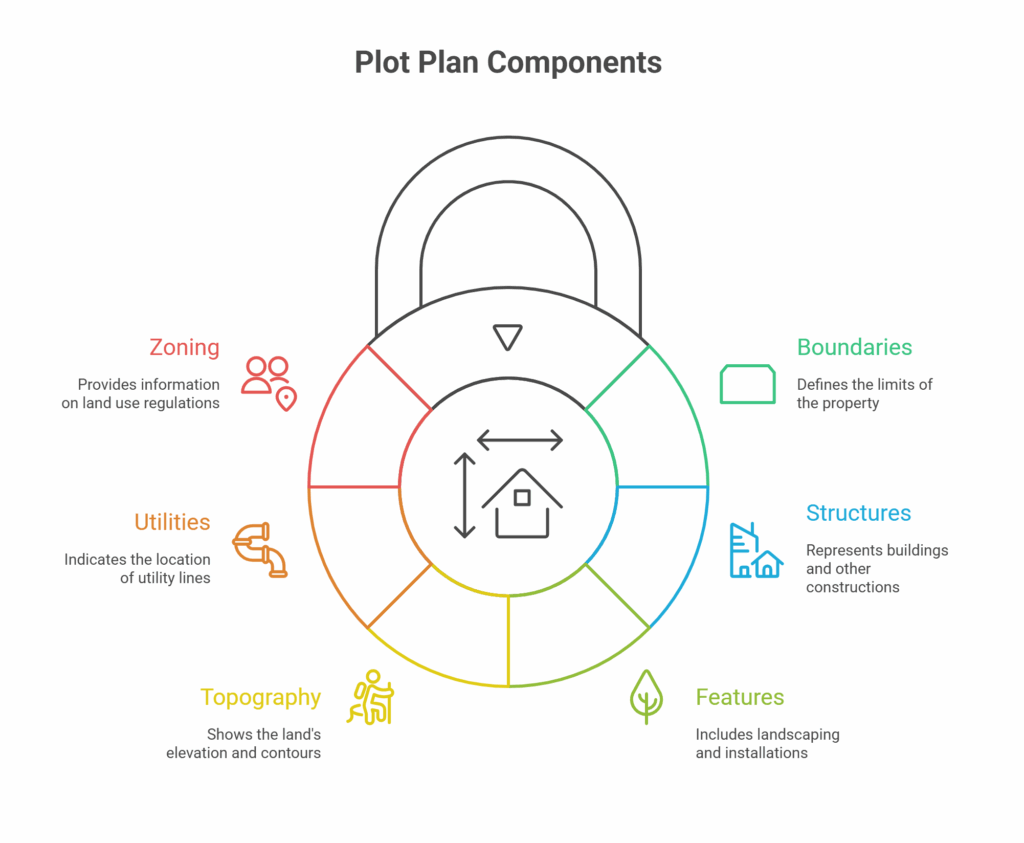Quick Answer: What Does a Plot Plan Show?
What Does a Plot Plan Show? A plot plan is essentially a detailed map of a property that highlights boundaries, structures, and important site features. It answers questions about where a house, driveway, garage, or fence sits in relation to property lines, easements, and setbacks. By providing a scaled drawing, it helps homeowners, contractors, and city officials clearly understand how the property is laid out.
Whether you’re building, remodeling, or selling, knowing What Does a Plot Plan Show? ensures compliance with zoning regulations, avoids boundary disputes, and gives a reliable snapshot of how land is used and what changes are possible.
Now let’s dive deeper.

From Paper to Property: A Real-Life Example
Imagine you’ve just bought a piece of land, ready to build your dream home. The builder hands you a sheet covered in lines, measurements, and symbols—it’s your plot plan. Without it, you’d be guessing where your driveway ends, how close the neighbor’s fence is, or whether your new deck will fit within zoning limits.
A plot plan takes the guesswork out, giving you the precise layout before a single nail is hammered.
The Big Picture in a Small Space
At first glance, a plot plan might look like a jumble of lines and numbers. But each detail tells part of your property’s story:
- The lot boundaries mark exactly where your land starts and ends.
- Structures like the house, garage, and sheds are placed in proportion.
- Distances between buildings, fences, and property lines show how space is used.
- Setback lines reveal how close you’re allowed to build to the property edges.
Why a Plot Plan Matters?
A plot plan isn’t just for builders—it’s a tool for:
- Homeowners making renovations or additions.
- Real estate buyers wanting clarity before purchase.
- Municipal officials ensuring zoning compliance.
- Neighbors settling boundary disputes.
Without it, you could risk legal trouble, failed inspections, or expensive rework.
Reading a Plot Plan Without Getting Lost
Plot plans use symbols and measurements that can feel technical, but a few tips make them easier to understand:
- Look for the scale—it shows how the drawing relates to actual measurements.
- Identify north so you can orient the plan to the real property.
- Focus on labelled features—driveways, fences, utilities, and easements.
- Pay attention to notes—these often include legal requirements like drainage or access points.
Beyond the Basics
Some plot plans also include:
- Topography showing slopes or elevation changes.
- Utility maps indicating water, sewer, and electrical lines.
- Easements that allow access for utilities or neighboring properties.
These details are especially important if you plan construction or landscaping.
Common Misunderstandings About Plot Plans
- They’re not the same as a property survey: A survey confirms boundary lines; a plot plan shows how everything fits within them.
- They’re not permanent: If you add a garage, pool, or fence, the plot plan will need updating.
- They’re not only for big projects: Even a small shed installation can benefit from a plot plan to avoid zoning violations.
Final Words
A plot plan is your property’s blueprint from above—a scaled, precise guide that shows exactly what’s there and where it belongs. Whether you’re buying, building, or making changes, it’s an essential tool for planning and compliance.
If you’re looking for a simple way to sell your property without the delays of traditional listings, cash home buyers in El Paso can make you a fair, no-obligation offer and close in as little as 7 days.
Call us anytime at 713-561-5162 or connect with us on our website and we’ll lay out all of your options for your specific situation.
Is a plot plan the same as a property survey?
No. A survey verifies property boundaries and legal descriptions, while a plot plan visually shows those boundaries along with structures, utilities, and other features.
Who prepares a plot plan?
Plot plans are usually created by licensed land surveyors, civil engineers, or architects, depending on the project and local regulations.
Do I need a plot plan for small projects like adding a shed or fence?
In many areas, yes—especially if zoning laws dictate setback distances or if the project could affect property boundaries.
How much does a plot plan cost?
Costs vary by location, property size, and complexity, but most range from $200 to $1,000.
Can a plot plan be outdated?
Yes. If new structures, fences, or significant landscaping changes have been made since the last plan, it should be updated for accuracy.
